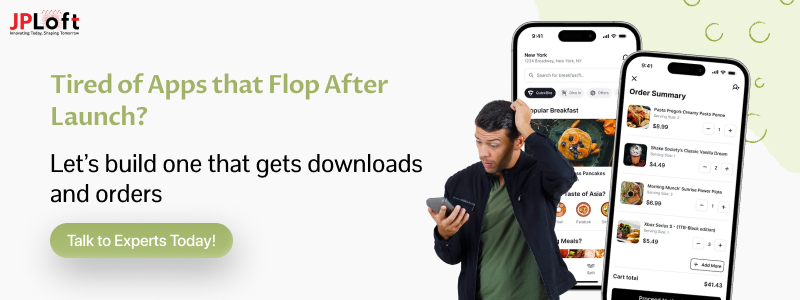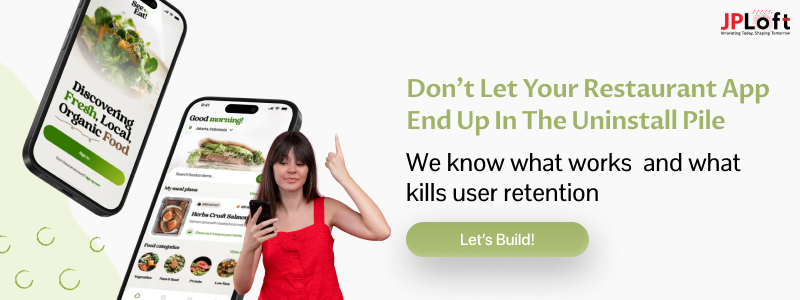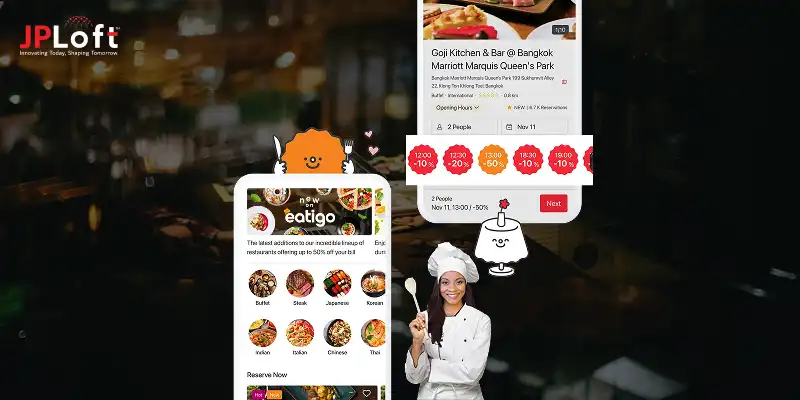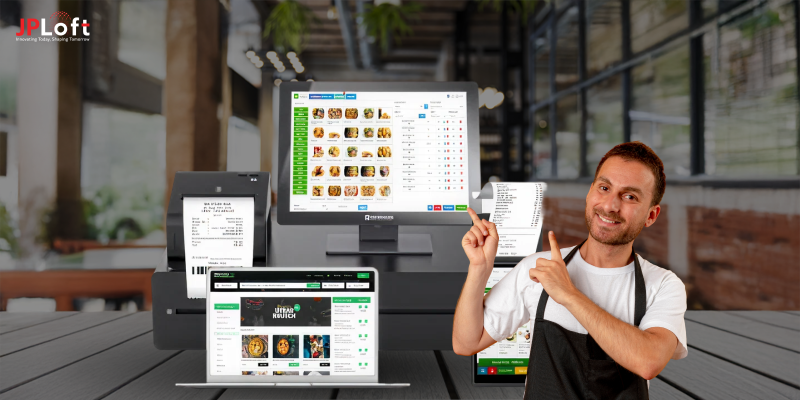In the race to digitize dining, restaurant apps promised convenience, speed, and loyalty. Yet, many vanish within months of launch. So, why do restaurant apps fail even with solid funding, sleek UI, and hungry markets?
The answer lies in more than just poor coding or design flaws. It’s a mix of missed expectations, lack of differentiation, and failing to address real diner needs.
If you’re building or running a food app, understanding the reasons why a restaurant app fails isn’t optional; it’s mission-critical. In this blog, we’ll break down the numbers, stories, and strategies behind restaurant app failure and show you how to avoid becoming the next cautionary tale.
Key Takeaways
Most restaurant apps fail due to poor UX, weak tech, or lack of differentiation.
Common failures include skipping testing, bloated features, and no monetization plan.
Apps that align with brand identity and user needs have a higher success rate.
AI features like personalization and chatbots can boost engagement and reduce churn.
Understanding why restaurant apps fail helps brands build smarter, more resilient solutions.
Partnering with the right development team ensures long-term scalability and technical success.
The Rise (and Struggles) of Restaurant Apps: What the Numbers Say!
The restaurant app market is growing fast, but so is its failure rate. As mobile ordering becomes a norm rather than a novelty, brands are under pressure to deliver seamless digital experiences or risk losing relevance.
Here’s a snapshot of what’s happening in 2025 and beyond:
-
- The global food delivery app industry is projected to reach $483 billion by 2032, growing at a CAGR of 10.3%. But growth alone doesn’t guarantee success. A rising number of developers are facing restaurant app failure, often within the first year of launch.
- Nearly 60% of restaurant mobile apps are deleted within 30 days, largely due to slow performance, clunky UX, or missing features that diners expect. That’s a clear sign of how competitive and unforgiving the space has become.
- By 2026, mobile-first restaurant platforms are expected to handle 80% of digital food orders. Still, many brands face online restaurant app failure because they focus too much on aesthetics and not enough on functionality, personalization, or scalability.
The problem isn’t limited to the apps alone. Broader restaurant startup failure is often tied to poor app planning and rushing to market without real feedback, testing, or differentiation.
Research shows that the top reasons why a restaurant app fails often include bloated features, no clear monetization model, and ignoring what users actually want. These aren't technical issues; they're strategic missteps.
In short, today’s restaurant apps must do more than just take orders; they need to solve problems, build loyalty, and feel effortless to use.
So, why do restaurant apps fail despite a booming industry? Let’s unpack the facts and explore what separates winners from apps that fade out quickly.
Why Restaurant Apps Fail: Key Stats and Real-World Reasons
With the food tech industry thriving, you’d think every restaurant app is a recipe for success. Yet the opposite is often true. Studies show that restaurant app failure is not only common, it's often predictable. So let’s find out. Why do restaurant startups fail?
Here’s a breakdown of the real reasons behind these collapses.
1. Lack of User-Centric Design
No matter how beautiful an app looks, if users struggle to place an order or track delivery, they’ll uninstall it. More than 38% of users delete restaurant apps due to confusing navigation or missing features, a clear sign of restaurant mobile app failure caused by poor UX planning.
Want to avoid that fate? It starts with understanding the top restaurant app features customers actually expect, like easy menu filtering, payment options, and live order tracking.
2. No Differentiation or Brand Personality
Cloning big-name apps might sound smart, but it rarely works. Consumers can spot a generic app from a mile away. Successful platforms reflect the brand identity of the restaurant, something many failures miss.
Apps that feel generic often contribute to restaurant app failures due to a lack of emotional engagement or incentive to stay.
3. Weak Technical Foundation
Unstable performance, bugs, and crashes don’t just frustrate users; they destroy trust. In a world where 1-star reviews can go viral, apps must launch clean. Yet, restaurant startup failure often ties directly to skipping proper QA or scaling too soon.
It's crucial to address restaurant app development challenges early, from backend scalability to device compatibility.
4. No Real Monetization Strategy
Many apps launch without thinking about how to sustain themselves. Loyalty rewards? Delivery fees? Subscription models? The lack of a financial blueprint is a silent killer.
Founders often overlook the cost to develop a restaurant app, focusing only on launch and ignoring future scalability, maintenance, and making expenses. That short-sighted approach is one reason restaurant startups fail; the tech was never aligned with long-term revenue goals.
5. Ignoring Feedback and Metrics
If you’re not tracking how users behave or what they’re saying, you’re guessing, and that rarely ends well. Many restaurant apps skip analytics and ignore feedback, leading to poor decisions and frustrated users.
The best apps evolve through data. Listen, adapt, and improve because staying still in this market is the fastest way to fail.
By understanding these real-world issues and the reasons why a restaurant app fails, you’ll be better positioned to avoid becoming just another statistic.
Case Studies: Restaurant Apps That Failed
Let’s move beyond theory. What actually happens when a restaurant app fails?
These examples reveal how common pitfalls, ranging from weak execution to flawed strategy, can derail even promising apps.
Case Study 1: A Well-Funded App, Poor Execution
A multi-location pizza chain launched an app with heavy investment in custom UI, exclusive deals, and real-time GPS tracking. But the app failed within six months. Why? It crashed frequently, was slow to update inventory, and offered no guest checkout.
Despite being visually appealing, it fell victim to restaurant app failure because it prioritized aesthetics over performance. What users wanted was convenience, not flair.
The chain had also skipped competitor analysis. Had they studied the best restaurant apps, they might’ve seen how simplicity outperforms complexity in fast-food environments.
Case Study 2: Copycat Concept, No Brand Voice
A new vegan café modeled its app on a national food delivery app. While it looked familiar, users found no real reason to stay. Reviews cited a lack of personality, a generic UX, and no reward incentives.
This app is a textbook case of restaurant app failures due to a lack of brand alignment and poor audience targeting. The team had underestimated the importance of experience over resemblance.
They also missed crucial restaurant app development trends like loyalty integration, social logins, and AI-powered personalisation, which their competitors were already leveraging.
Case Study 3: Big Vision, No Budget Reality
A reservation-focused app for local bistros tried to replicate the success of OpenTable. But it lacked live-table sync, CRM integration, or premium UI. The concept was great, but poor execution and no funding for critical features killed momentum.
Before attempting similar models, it’s essential to research the actual cost to build a restaurant reservation app like OpenTable.
Most startups fail here, not because of bad ideas, but because they underestimate the tech stack and backend investment required.
These case studies underline the real-world risks of launching untested, misaligned, or tech-deficient platforms. If you want your idea to succeed, studying failed apps is just as important as studying successful ones.
How to Avoid Restaurant App Failure: Practices That Actually Work
Avoiding restaurant app failure isn’t about luck; it’s about making smart, customer-focused decisions from day one.
Whether you’re launching a new app or trying to fix one that’s underperforming, these practices can make the difference between a flop and five-star reviews.
► Start with a Clear Product-Market Fit
Don’t build just another food ordering app; solve a real problem. Are you addressing a hyper-local market, a niche audience, or a specific cuisine gap? Without this clarity, even beautifully designed apps fail to gain traction.
Before writing a single line of code, it's worth stepping back to evaluate how to start an online restaurant business that complements your app strategy. Apps succeed when they support a clear business model, not the other way around.
It helps to explore creative restaurant app ideas before diving into development. Innovation often starts with narrowing your focus, not broadening it.
► Design for Simplicity and Speed
Users expect your app to be intuitive, fast, and accessible. Avoid cluttered interfaces, excessive steps at checkout, or slow loading times.
Following a proven restaurant app design guide can help you build an experience that feels natural and friction-free. Think about user flows, accessibility, and mobile responsiveness from the very beginning.
► Test Early, Test Often
Launching an app without testing is one of the top causes of restaurant mobile app failure. Functional testing, UX testing, and load testing should happen at every development stage.
Skipping this step often leads to frustrated users, poor reviews, and uninstalls. Don’t just fix bugs; prevent them.
► Focus on Scalable Tech Architecture
A major reason behind restaurant startup failure is weak infrastructure. What works for 100 users might crash at 10,000. Choose scalable APIs, modular codebases, and reliable cloud hosting early on.
If you’re unsure, it’s smarter to hire dedicated developers who understand the demands of food service apps and can future-proof your platform.
► Think Monetization from the Start
Your app shouldn’t just function; it should fund your business. Consider how your features tie into revenue, whether through delivery fees, upsells, subscriptions, or partner integrations.
If you’re unsure where to begin, explore how restaurant apps make money in different markets. A monetization strategy isn’t optional; it’s survival.
Pro Tip:
Don't try to be everything to everyone. Simplicity, performance, and clear value win every time.
With these foundational practices in place, your app is already 10 steps ahead of the competition. Next, let’s look at how AI can give you an unbeatable edge.
How AI in Restaurant Apps Reduces Failure and Boosts Growth?
If your restaurant app has the basics down like intuitive design, solid tech, and a clear market fit, AI can take it from functional to phenomenal. In today’s hyper-competitive space, artificial intelligence isn’t a luxury; it’s a growth engine.
Forward-thinking brands now explore how to create an AI app that not only automates operations but also delivers personalized customer experiences, smart recommendations, and real-time analytics. From the kitchen to customer service, AI helps restaurants do more with less, smarter.
1] Personalized Menus and Smart Recommendations
AI can track user preferences over time to suggest the right dishes, upsell intelligently, and even adapt menus based on time of day or location. This type of personalization builds loyalty and drives repeat orders.
Many AI in restaurant apps use machine learning to offer dietary filters, reorder suggestions, or combo prompts, all of which boost conversion rates and customer satisfaction.
2] AI Chatbots and Order Automation
AI chatbots can handle bookings, support queries, or even entire order flows. With voice input and natural language processing, users can interact as naturally as they would with staff.
This kind of innovation should be considered early when exploring how to develop a restaurant app. Integrating AI from day one simplifies operations later and avoids costly rebuilds.
If you lack in-house AI talent, consider hiring an AI app development company that specializes in NLP, predictive analytics, and restaurant automation.
3] Demand Prediction and Smart Inventory
AI can predict peak hours, monitor usage trends, and reduce food waste through smarter purchasing decisions. This not only improves margins but also ensures customer satisfaction by avoiding delays or stock-outs.
To scale these features smoothly, partnering with the best app development company ensures your tech stack can grow with your business. From architecture to post-launch analytics, execution matters.
Pro Tip:
Start with one feature, like predictive ordering or chatbot automation, then track results and scale accordingly.
You don’t need to build everything at once. But in 2025, not building with AI at all might be your biggest mistake.
Need Help Developing a Restaurant App That Doesn’t Fail? Talk to JPLoft
Building a restaurant app isn’t just about launching a product; it’s about creating a seamless, scalable experience that your customers love using again and again.
At JPLoft, we help you avoid the common pitfalls that lead to failure. From strategy and UX/UX design to AI integration and post-launch support, we guide your app journey end-to-end.
Whether you’re starting fresh or revamping an existing platform, we’re the restaurant app development company that understands what success truly takes in 2025.
Let’s build something customers won’t just download but depend on. Talk to our experts today!
Conclusion
Restaurant app failure isn’t always about poor ideas; it’s often the result of avoidable mistakes. Whether it’s rushed development, weak UX, or lack of differentiation, many restaurant app failures could be prevented with smarter planning.
Understanding the reasons why a restaurant app fails helps founders shift from reactive fixes to a proactive strategy. And in 2025’s competitive market, that’s critical.
If you want to avoid becoming another restaurant startup failure, focus on scalable tech, thoughtful design, and long-term user engagement.
A successful app isn’t built overnight, but with the right approach, it won’t be one that disappears overnight either.
FAQs
Most restaurant apps fail due to poor user experience, lack of a clear monetization plan, or weak technical foundations. Many also skip post-launch support, causing bugs and performance issues that turn users away.
The top reasons include:
Confusing UI/UX design
Missing features like live tracking or loyalty programs
No brand identity or differentiation
No feedback loop or data analytics
Failure to align app goals with business strategy
Even with a strong launch, apps can fail if they:
Don’t update based on user feedback
Experience frequent crashes or bugs
Lack retention mechanisms
Don’t keep up with feature trends or customer expectations
While initial development costs vary, ongoing maintenance often ranges from $1,000 to $5,000 per month. This covers updates, bug fixes, hosting, and analytics, factors critical to avoiding restaurant app failure.
Yes. AI can improve personalization, automate customer service, predict demand, and enhance retention through smart insights. These innovations reduce operational strain and improve user experience.
Absolutely, if done strategically. With rising mobile orders and digital loyalty programs, the potential is huge. However, to succeed, you must avoid the common reasons why a restaurant app fails and focus on long-term user engagement and smart tech integration.
Even a great app can’t save a poor business model. Startup failure often stems from poor market fit, weak operations, or inadequate funding, all of which eventually reflect in app performance too.













Share this blog